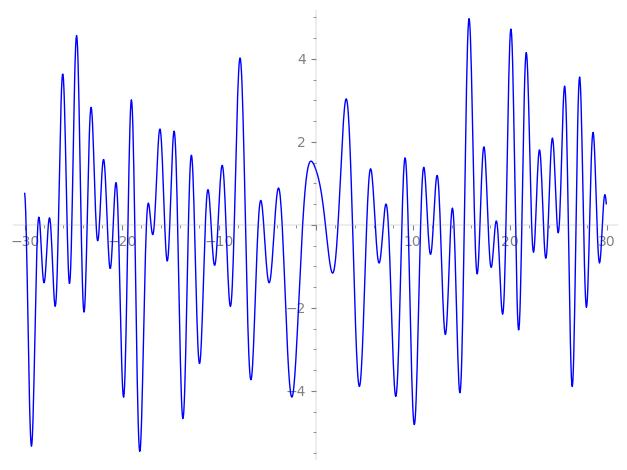| L(s) = 1 | + (−1.08 + 1.88i)3-s + (0.5 − 0.866i)5-s + (0.370 − 0.641i)7-s + (−0.870 − 1.50i)9-s + 2.91·11-s + (1.54 − 2.68i)13-s + (1.08 + 1.88i)15-s + (3.41 + 5.92i)17-s + (0.0887 − 0.153i)19-s + (0.806 + 1.39i)21-s + 3.43·23-s + (2 + 3.46i)25-s − 2.74·27-s − 4.61·29-s − 2.91·31-s + ⋯ |
| L(s) = 1 | + (−0.628 + 1.08i)3-s + (0.223 − 0.387i)5-s + (0.140 − 0.242i)7-s + (−0.290 − 0.502i)9-s + 0.879·11-s + (0.429 − 0.743i)13-s + (0.281 + 0.486i)15-s + (0.829 + 1.43i)17-s + (0.0203 − 0.0352i)19-s + (0.176 + 0.304i)21-s + 0.716·23-s + (0.400 + 0.692i)25-s − 0.527·27-s − 0.856·29-s − 0.524·31-s + ⋯ |
\[\begin{aligned}\Lambda(s)=\mathstrut & 592 ^{s/2} \, \Gamma_{\C}(s) \, L(s)\cr =\mathstrut & (0.471 - 0.882i)\, \overline{\Lambda}(2-s) \end{aligned}\]
\[\begin{aligned}\Lambda(s)=\mathstrut & 592 ^{s/2} \, \Gamma_{\C}(s+1/2) \, L(s)\cr =\mathstrut & (0.471 - 0.882i)\, \overline{\Lambda}(1-s) \end{aligned}\]
Particular Values
| \(L(1)\) |
\(\approx\) |
\(1.15103 + 0.690199i\) |
| \(L(\frac12)\) |
\(\approx\) |
\(1.15103 + 0.690199i\) |
| \(L(\frac{3}{2})\) |
|
not available |
| \(L(1)\) |
|
not available |
\(L(s) = \displaystyle \prod_{p} F_p(p^{-s})^{-1} \)
| $p$ | $F_p(T)$ |
|---|
| bad | 2 | \( 1 \) |
| 37 | \( 1 + (2.04 - 5.72i)T \) |
| good | 3 | \( 1 + (1.08 - 1.88i)T + (-1.5 - 2.59i)T^{2} \) |
| 5 | \( 1 + (-0.5 + 0.866i)T + (-2.5 - 4.33i)T^{2} \) |
| 7 | \( 1 + (-0.370 + 0.641i)T + (-3.5 - 6.06i)T^{2} \) |
| 11 | \( 1 - 2.91T + 11T^{2} \) |
| 13 | \( 1 + (-1.54 + 2.68i)T + (-6.5 - 11.2i)T^{2} \) |
| 17 | \( 1 + (-3.41 - 5.92i)T + (-8.5 + 14.7i)T^{2} \) |
| 19 | \( 1 + (-0.0887 + 0.153i)T + (-9.5 - 16.4i)T^{2} \) |
| 23 | \( 1 - 3.43T + 23T^{2} \) |
| 29 | \( 1 + 4.61T + 29T^{2} \) |
| 31 | \( 1 + 2.91T + 31T^{2} \) |
| 41 | \( 1 + (0.322 - 0.558i)T + (-20.5 - 35.5i)T^{2} \) |
| 43 | \( 1 - 3.48T + 43T^{2} \) |
| 47 | \( 1 - 9.79T + 47T^{2} \) |
| 53 | \( 1 + (3.37 + 5.83i)T + (-26.5 + 45.8i)T^{2} \) |
| 59 | \( 1 + (-3.72 - 6.45i)T + (-29.5 + 51.0i)T^{2} \) |
| 61 | \( 1 + (-3.67 + 6.36i)T + (-30.5 - 52.8i)T^{2} \) |
| 67 | \( 1 + (5.18 - 8.98i)T + (-33.5 - 58.0i)T^{2} \) |
| 71 | \( 1 + (-2.72 + 4.72i)T + (-35.5 - 61.4i)T^{2} \) |
| 73 | \( 1 - 12.3T + 73T^{2} \) |
| 79 | \( 1 + (6.26 - 10.8i)T + (-39.5 - 68.4i)T^{2} \) |
| 83 | \( 1 + (4.18 + 7.24i)T + (-41.5 + 71.8i)T^{2} \) |
| 89 | \( 1 + (7.85 + 13.6i)T + (-44.5 + 77.0i)T^{2} \) |
| 97 | \( 1 + 16.8T + 97T^{2} \) |
| show more | |
| show less | |
\(L(s) = \displaystyle\prod_p \ \prod_{j=1}^{2} (1 - \alpha_{j,p}\, p^{-s})^{-1}\)
Imaginary part of the first few zeros on the critical line
−10.78670166333803890351108089193, −10.07315269832823258385190217457, −9.248502184236362695774517187438, −8.398131914026157084543556913883, −7.24041032975179334035036522696, −5.93167298189212338003965530543, −5.36071449538516443739461965114, −4.24682874344543763245977686977, −3.45948987602340826279893889791, −1.34965228698998507930127492707,
1.00121999316913041046562763312, 2.29721989519170572514837296450, 3.79475800993879104745308891001, 5.25348923935079515668957889673, 6.13791545853542080047479164517, 6.96646711069549768213731149906, 7.48402505599287067297029048993, 8.878837903389863458564446671622, 9.531586131055382999876666856033, 10.81362707454883410691392517701

